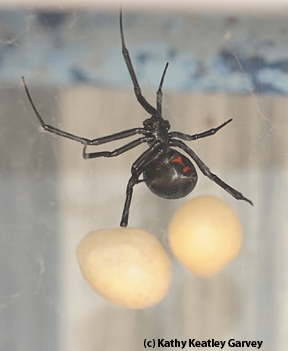
A sure-fire way to frighten arachnophobics is the very mention of "spiders"--especially on Halloween.
Spiders aren't insects but arthropods, order Araneae. They have eight legs, which according to some, are seven legs too many. They are also distinguished by their chelicerae with fangs that inject venom.
You've seen them. Black widow spiders. Jumping spiders. Crab spiders. Garden spiders.
If you fear them, there's a name for that fear: Arachnophobia. Wikipedia says that "People with arachnophobia tend to feel uneasy in any area they believe could harbor spiders or that has visible signs of their presence, such as webs. If arachnophobics see a spider, they may not enter the general vicinity until they have overcome the panic attack that is often associated with their phobia. Some people scream, cry, have trouble breathing, have excessive sweating or even heart trouble when they come in contact with an area near spiders or their webs. In some extreme cases, even a picture or a realistic drawing of a spider can also trigger fear."
So many myths about spiders. The Burke Museum of Natural History and Culture, University of Washington, Seattle, has posted some of the myths, misconceptions and superstitions on its website.
The general fallacies, as listed by Rod Crawford, curator of arachnids:
General Fallacies
- Spiders are insects.
- "Arachnid" is just a fancy name for spider.
- You can always tell a spider because it has eight legs.
- All spiders make webs.
- The orb web (round or "geometric" web) is a "normal" spider web.
- A "daddy-longlegs" is a kind of spider.
- Most spiders could not bite humans because their fangs are too small.
- Any spider species can be found anywhere.
- All spiders are male.
- Spiders are most numerous in late summer.
- You are never more than three feet from a spider.
- Spiders "suck the juices" of their prey, and do not literally eat it.
- Spiders don't stick to their own webs because their feet are oily.
Meanwhile, over at the Bohart Museum of Entomology at the University of California, Davis, plans are underway for an open house themed "Insect Myths." They will focus on spider myths, too.
The event, free and open to the public, is set for Sunday, Nov. 23 from 1 to 4 p.m. in Room 1124 of the Academic Surge Building on Crocker Lane, off LaRue Road. Directed by Lynn Kimsey, professor of entomology at UC Davis, the museum houses a global collection of nearly eight million specimens and is the home of the seventh largest insect collection in North America, and the California Insect Survey, a storehouse of the insect biodiversity. The museum is open to the public four days a week, Monday through Thursday (9 a.m. to noon and 1 to 5 p.m.) but it sponsors special weekend open houses as well.
The remaining schedule:
- Sunday, Nov. 23: “Insect Myths,” 1 to 4 p.m.
- Saturday, Dec. 20: “Insects and Art,” 1 to 4 p.m.
- Sunday, Jan. 11: “Parasitoid Palooza,” 1 to 4 p.m.
- Sunday, Feb. 8: “Biodiversity Museum Day,” noon to 4 p.m.
- Saturday, March 14: “Pollination Nation,” 1 to 4 p.m.
- Saturday, April 18: UC Davis Picnic Day, 10 a.m. to 3 p.m.
- Sunday, May 17: “Name That Bug! How About Bob?” 1 to 4 p.m.
- Saturday, July 18: “Moth Night,” 8 to 11 p.m.
When you attend the Bohart Museum open houses, you'll probably have the opportunity to hold and/or photograph "Rosie," a 24-year-old tarantula. It's one of the critters in the live "petting zoo," which also includes Madagascar hissing cockroaches, millipedes and walking sticks.
Attached Images:


